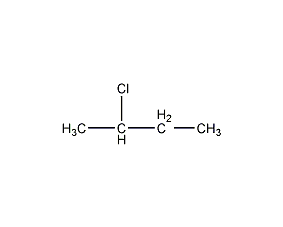
Structural formula
| Business number | 01NS |
|---|---|
| Molecular formula | C4H9Cl |
| Molecular weight | 92.57 |
| label |
2-Chloro-3-methylpropane, 2-Chlorobutane, Butane chloride, 2-butyl chloride, sec-butyl chloride, Chlorinated sec-butane, sec-Butyl chloride, 1-Chloro-1-methylpropane, 2-Chloro-3-methylpropane, 1-Methylpropyl chloride, CH3CH2CHClCH3, plasticizer, pesticides, Surfactant, Halogenated hydrocarbon solvents |
Numbering system
CAS number:78-86-4
MDL number:MFCD00000871
EINECS number:201-151-7
RTECS number:EJ6475000
BRN number:1718770
PubChem number:24892543
Physical property data
1. Properties: Colorless and transparent liquid with an ether-like odor. [1]
2. Melting point (℃): -140~-131[2]
3. Boiling point ( ℃): 68~70[3]
4. Relative density (water=1): 0.87[4]
5. Relative vapor density (air=1): 3.2[5]
6. Saturated vapor pressure (kPa): 10.65 (78.4℃)[6]
7. Critical temperature (℃): 247.5[7]
8. Critical pressure (MPa): 3.9[ 8]
9. Octanol/water partition coefficient: 2.33[9]
10. Flash point (℃): -15 [10]
11. Explosion upper limit (%): 10.1[11]
12. Explosion lower limit (%) : 1.8[12]
13. Solubility: Slightly soluble in water, miscible in most organic solvents such as ethanol, ether, and chloroform. [13]
14. Viscosity (mPa·s, 15ºC): 0.439
15. Heat of evaporation (KJ/mol, b.p.): 29.22
16. Conductivity (S/m, 30ºC): 10-7~10-10
17. Relative density (25℃, 4℃): 0.8677
18. Refractive index at room temperature (n25): 1.3942
19. Parameter (J·cm-3)0.5: 16.461
20. van der Waals area (cm2·mol-1): 7.960×109
21. van der Waals volume (cm3·mol-1) :55.970
22. The gas phase standard claims heat (enthalpy) (kJ·mol-1): -161.2
23. The liquid phase standard claims heat ( Enthalpy) (kJ·mol-1): -192.8
24. Liquid phase standard hot melt (J·mol-1·K-1): 158.1
Toxicological data
1. Acute toxicity Rat caliber LD50: 120ml/kg; Rat inhalation LC50: 8000PPM/4H; Rabbit skin LD50: 20ml/kg.�
2. Chronic toxicity/carcinogenicity TDLO in mouse abdominal cavity: 3240 mg/kg/8W-I;
3. It is irritating and anesthetic, can damage the liver, and is toxic Larger than chlorobutane.
4. Acute toxicity[14] LD50: 17460mg/kg (rat oral); 20000mg/kg (rabbit transcutaneous)
Ecological data
1. Ecotoxicity No data available
2. Biodegradability No data available
3 .Non-biodegradability No information available
4. Other harmful effects[15] This substance May be harmful to the environment, special attention should be paid to water bodies.
Molecular structure data
1. Molar refractive index: 25.38
2. Molar volume (cm3/mol): 106.3
3. Isotonic specific volume (90.2K ): 227.1
4. Surface tension (dyne/cm): 20.8
5. Polarizability (10-24cm3): 10.06
Compute chemical data
1. Reference value for hydrophobic parameter calculation (XlogP): None
2. Number of hydrogen bond donors: 0
3. Number of hydrogen bond acceptors: 0
4. Number of rotatable chemical bonds: 1
5. Number of tautomers: none
6. Topological molecule polar surface area 0
7. Number of heavy atoms: 5
8. Surface charge: 0
9. Complexity: 19.6
10. Number of isotope atoms: 0
11. Determine the number of atomic stereocenters: 0
12. Uncertain number of atomic stereocenters: 1
13. Determine the number of chemical bond stereocenters: 0
14. Number of uncertain chemical bond stereocenters: 0
15. Number of covalent bond units: 1
Properties and stability
1. It is flammable, and its vapor and air can form an explosive mixture, with an explosion limit of 1.8-10.1%. In case of open flame or high heat, it can cause combustion and explosion. Decomposed by high heat to produce toxic and corrosive fumes. Without a catalyst or in the presence of calcium chloride, heat to 450~550°C to remove hydrogen chloride to produce a mixture of 1-butene and cis- and trans-2-butene. It reacts with benzene in the presence of anhydrous aluminum trichloride to form sec-butylbenzene.
2. Stability[16] Stable
3. Prohibited use Substances[17] Strong oxidants, strong bases
4. Conditions to avoid contact[ 18] Heating
5. Polymerization hazard[19] No polymerization
6. Decomposition products[20] Hydrogen chloride
Storage method
Storage Precautions[21] Store in a cool, ventilated warehouse. Keep away from fire and heat sources. The storage temperature should not exceed 37℃. Keep container tightly sealed. They should be stored separately from oxidants and alkalis, and avoid mixed storage. Use explosion-proof lighting and ventilation facilities. It is prohibited to use mechanical equipment and tools that are prone to sparks. The storage area should be equipped with emergency release equipment and suitable containment materials.
Synthesis method
Originated from the reaction of 2-butanol and hydrochloric acid in the presence of zinc chloride.
Purpose
1. Used in medicines, plasticizers, pesticides, rubber, resins, surfactants, etc.
2. Used in organic synthesis and as solvent. [22]

 微信扫一扫打赏
微信扫一扫打赏

